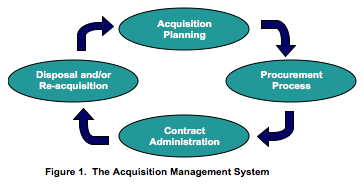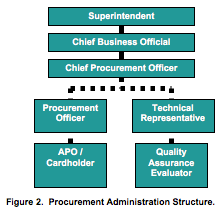- Rock Hill Schools
- Acquisition Strategy
Procurement Services
Page Navigation
Acquisition Strategy of Rock Hill Schools
-
Introduction and Purpose
Rock Hill Schools expends over $30 million each year in procurement and purchasing of goods and services to support the mission of the district. This volume of purchasing is executed through more than 35,000 individual contracting actions annually, and is governed by the Rock Hill Schools Consolidated Procurement Code and the associated Purchasing Procedures Manual, both adopted July 1, 2008. Together, the Code and the Manual provide sufficient guidance for conducting the contracting actions themselves, but do not address all aspects of the acquisition management system.
 Our acquisition management system is comprised of four stages arranged as a “life cycle,” shown as Figure 1.
Our acquisition management system is comprised of four stages arranged as a “life cycle,” shown as Figure 1.The purpose of this Acquisition Strategy is to outline a comprehensive, systematic management approach to district procurement and purchasing. This strategy will focus on the Acquisition Planning and Contract Administration processes, which balance and complement the concentration of the Purchasing Procedures Manual and the Consolidated Procurement Code on the Procurement and Disposal Processes.
Acquisition Planning
The starting point of the system is the most critical process and the prime focus for improvement. Three major components are procurement type, competition requirement and contract type/procurement method:
1. Procurement Type: Deciding What to Purchase
- is the foundation for a successful acquisition. Deliberate, clear two-way communication between the “customer” (our schools and departments) and the acquisition professional (AP) is essential:
- Customers must accurately and completely describe their true requirements in terms of quality, cost and responsiveness.
- The AP must objectively define the requirement in terms of the spectrum of procurement types that the district can purchase. The Code describes broad categories of procurement types, such as construction, professional services, supplies, etc. Some of these categories have specific governing statutes and regulations, such as Brooks Bill procedures for Architect/Engineer Services. Certain products and services are exempted from procurement procedures, such as legal, financial and professional services. A list of the most common types of procurement may be found in the Purchasing Procedures Manual.
- Both must collaboratively discuss new product, service and process innovations as well as alternative sources and methods available in the marketplace.
Consistent with its educational mission and stewardship of public resources, Rock Hill Schools shall seek alternative sources for products and services which cannot be produced directly by district staff or processes with optimum quality, cost and responsiveness. Opportunities for cooperative purchasing with other districts, shared services with other local government agencies, and outsourcing of district functions will be considered on a case-by-case basis.
OutsourcingIn an educational climate of increasing requirements and expectations and declining resources, many districts have turned to outsourcing of district functions to the commercial sector. While Rock Hill Schools recognizes this trend and has outsourced certain functions successfully in the past, we choose to view this practice as a tool rather than a trend. Outsourcing of district functions (major products and services) should be considered only through a deliberate, stakeholder-involved and team-driven process. The process itself should result in a business case to change (or retain) the source of the service through a Benefit/Cost Analysis, based on variables such as:
- Criticality of function to the district’s core mission – the more critical, the less potential to outsource.
- Capacity of the district to support the function – is the overhead a reasonable burden?
- Level of job skill in the function and the district investment to retain this skill in a competitive job market.
- Ability to completely specify the duties or service performed – less defined work has less potential to outsource.
- Cost of providing the function on a FTE basis.
- Savings sufficient to offset costs to transition sources – new source should be at least 10% more efficient, or higher quality, or both.
- Market availability for the good or service (e.g. no sources for moving wrestling mats)
2. Competition Requirement: Deciding Where to Purchase - stems from the discussion of alternative sources and methods available in the marketplace. Options available to the planning team include:
- Full and Open Competition
- Limited Competition – through established “bidder’s lists” or the procurement method itself
- Prequalification – from a separately maintained Qualified Products List (QPL) or Request For Qualifications (RFQ)
- Sole Source Procurements – where compatibility or unique features must be met
- Emergency Procurements – when health or safety are threatened or operations are impacted.
Rock Hill Schools shall foster competition in each acquisition action to fullest extent practicable in order to (a) maximize the purchasing value of public funds, and (b) ensure fair and equitable treatment of all persons, firms and concerns in the business community and marketplace.
3. Contract Type and Procurement Method: Selecting How To Purchase - can be accomplished once the customer’s true requirements are known and the market for the purchase is identified. The AP can “design the procurement” by using the best:
Contract Type. Options available in the Code are:
- Fixed Price and/or Delivery – used when requirements for quality, quantity and timeframe are precisely defined. Vendor assumes most risk.
- Indefinite Delivery and Quantity (IDQ) – used when requirements are less defined but the vendor can supply or perform at a firm unit price and delivery timeframe once ordered
- Cost Reimbursement – used when requirements for quality, quantity and timeframe cannot be accurately defined. District assumes most risk. (Requires approval of the Superintendent.)
Procurement Method
Options explained in the Code and the Manual include:
- Competitive Sealed Bids – the “default” method, with an Invitation For Bids (IFB) and award to the lowest priced, responsive, responsible bidder. Used when requirements are well defined, and price is the dominant factor.
- Competitive Best Value Bids – A Request For Proposals (RFP), followed by a combination of (a) negotiating and ranking technical proposals, then (b) awarding to the lowest bid of the top two proposing firms. Used when requirements are less defined, but price is still the major (60%) factor.
- Competitive Sealed Proposals – A RFP and negotiations / ranking of proposals based on factors other than price. Requirements are defined through negotiation in this method.
- Simplified methods with delegated authority are Small Purchases and Procurement Cards. Other methods are available for specialized situations.
Rock Hill Schools shall analyze and design each acquisition action, selecting the best contract type and procurement method depending on the degree of quality, quantity and timing defined, the flexibility required and the assumption of risk.
Contract Administration
The Code and the Manual require the Superintendent to develop an organizational structure to provide the greatest benefit for the district in accordance with the ethical practices for the acquisition profession. The contract administration process relies on this structure to produce accountability, efficiency and assurance of quality throughout the acquisition life cycle. The Chief Procurement Officer relies on this structure for acceptance of goods and services, evaluation of vendor performance and resolution of disputes and claims. Figure 2 shows the recommended Procurement Administration Structure, based on the latest South Carolina Model Procurement Code and the Acquisition Profession.
 The authority of the Superintendent, CBO and CPO are designated and may be delegated according to the Procurement Code. The CPO may delegate procurement authority to a Procurement Officer (PO) at a school or department, such as a bookkeeper.
The authority of the Superintendent, CBO and CPO are designated and may be delegated according to the Procurement Code. The CPO may delegate procurement authority to a Procurement Officer (PO) at a school or department, such as a bookkeeper.A school or department may appoint a Technical Representative (TechRep) and Quality Assurance Evaluator(s) (QAEs) to the CPO to assist the CPO in acquisition planning, procurement and contract administration processes. The role of these “internal customer” positions is crucial to defining the requirements / specifications, supporting negotiation, assuring quality in work performance and accepting and evaluating goods and services delivery. These appointments should be in writing and may be for a specific purchase action or for all actions within a designated procurement type.
Rock Hill Schools shall regard Procurement Administration to be the inherent function of the government and its employees unless specifically approved by the Superintendent, and shall ensure adequate, trained staff are hired or appointed to carry out the roles and responsibilities of the prescribed organizational structure.

